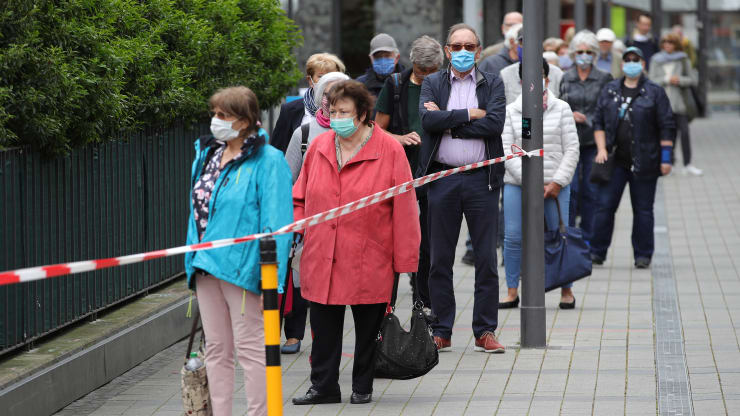The ‘R’ rate is the new coronavirus buzzword: Here’s what it means and why it matters

As countries across Europe begin to lift their lockdowns, close attention has been compensated towards the so-known as “R” rate being an symbol of whether another wave of coronavirus infections might be coming.
Epidemiologists and governments are not only watching the daily number of instances recorded as limitations are lifted, they’re also keeping an eye on this key metric in gauging the coronavirus’ capability to spread.
Also referred to as the “basic reproductive number” or R value or rate, the figure signifies the amount of secondary infections produced by one infected individual, typically, presuming there’s no immunity among a population already.
To put it simply, it provides experts a sign from the extent that the coronavirus has been spread, or reproduced, among a population.
Health government bodies around Europe are attempting to get – and – their R rate under 1 to slow multiplication from the virus. The greater the reproduction rate, the greater the chance of the herpes virus distributing tremendously. Having a rate under 1, however, a crisis could be easier contained.
Germany motivated concern Tuesday if this stated that it is R rate had elevated as much as 1., from .7 earlier in April, just like the country began to reopen its economy.
“The number should stay below one, that’s the big goal,” Lothar Wieler, obama from the Robert Koch Institute for infectious illnesses (RKI) in Germany told a news conference Tuesday.
“The further it’s below one, the greater secure we are able to feel, the greater leeway we’ve, but there are more figures which are important too,” he stated, including the amount of cases each day, and testing capacity. On Thursday, however, the RKI stated the reproduction rates are presently believed at .76 typically.
Watching the information
While Germany has witnessed an identical quantity of confirmed coronavirus cases to the European peers (161,539 cases Thursday, based on data published by Johns Hopkins College), it’s seen far less deaths, with 6,467 fatalities recorded. By comparison, Italia, the U.K. and The country have reported 27,682, 26,097 and 24,275 deaths correspondingly.
Apparently on the top of their outbreak, but conscious of the potential risks of lifting limitations, Germany tentatively began to unwind some lockdown measures last Monday by permitting smaller sized stores to re-open, with increased limitations set to become lifted within the coming several weeks.
Requested whether the increase in the R rate should give Germany pause for thought with regards to relaxing its lockdown, the Robert Koch Institute stated the figure was one of many things to consider.
“The RKI doesn’t choose lockdown or exit,” a spokesperson for that institute told CNBC Tuesday. “We supply the epidemiological basis, however the decision is around the political side – who’ve to think about and weigh the rest of the societal factors too.”
The spoksperson added that they seen a loss of cases, adding: “I think overall, we did comparatively well to date, so we were very lucky to determine cases that early, but we still need to be very careful and we must observe carefully how everything develops.”
Calculating the R rate
Estimating the reproduction value isn’t a precise science and various countries and experts use different record and mathematical models to estimate the level that herpes has been reproduced among a population.
In early March, for instance, the planet Health Organization stated the reproductive number for Covid-19 was thought as between 2 and a pair of.5, greater compared to influenza, even though it noted that direct comparisons take time and effort.
The transmission from the coronavirus isn’t fully understood but social distancing and lockdown measures are targeted at restricting a virus’ reproductive rate by restricting contact and potential infection between individuals.
Spain’s leading epidemiologist and also the country’s health emergency chief, Fernando Simon, stated Wednesday that unless of course the R rate was below 1 typically in The country, and continued to be there, the nation wouldn’t consider easing mobility limitations. Just about all regions of The country presently possess a coronavirus reproduction rate below 1 presently, he noted.
The pm of Italia, that has been the toughest hit European country when it comes to deaths in the virus, cautioned Tuesday there would be a “strong risk” from the coronavirus coming back unless of course safety safeguards were noticed in the country’s second phase of lifting lockdown measures, beginning May 4.
The U.K., meanwhile, continues to be entirely lockdown and it is thought to be per week approximately behind its European neighbors with regards to the outbreak’s progression. Nevertheless, with 26,166 deaths in the virus by Wednesday (if this first incorporated deaths from Covid-19 in most settings and not simply hospitals, resulting in a clear, crisp rise in the fatality figure), chances are it will function as the worst hit country in Europe when it comes to fatalities.
Pressurized to announce an exit strategy, it’s watching its European neighbors carefully to determine what goes on as limitations are lifted. On Wednesday, Foreign Minister Dominic Raab stated “a second spike could be dangerous to public health insurance and it might lead to a lot more deaths from Covid-19, that by itself would result in a second lockdown inflicting further prolonged economic discomfort.”
Boris Manley is anticipated to inform the British public on Thursday the R rate is going to be crucial yardstick of whether or not to lift, or reinstate, limitations within the coming days, the BBC reported Thursday.